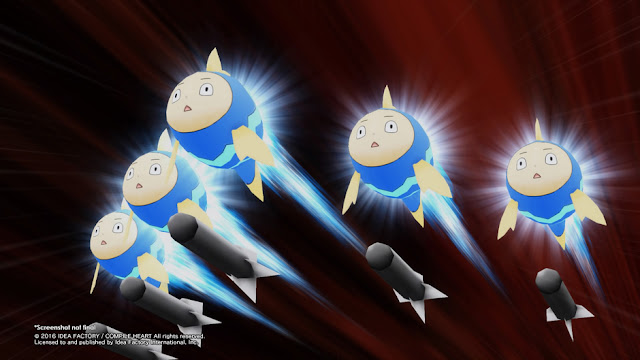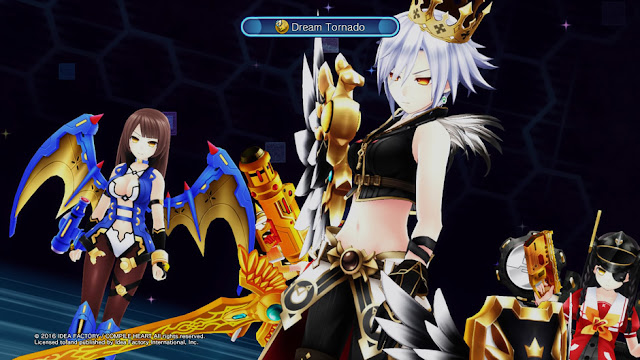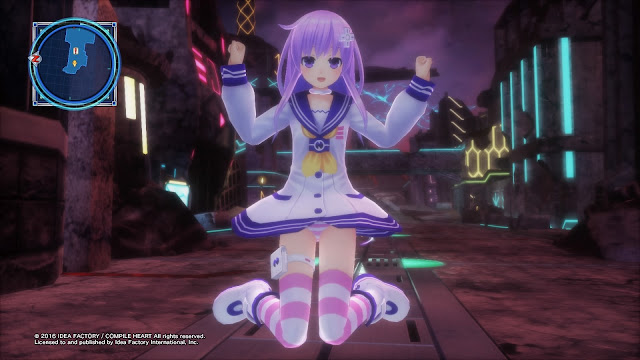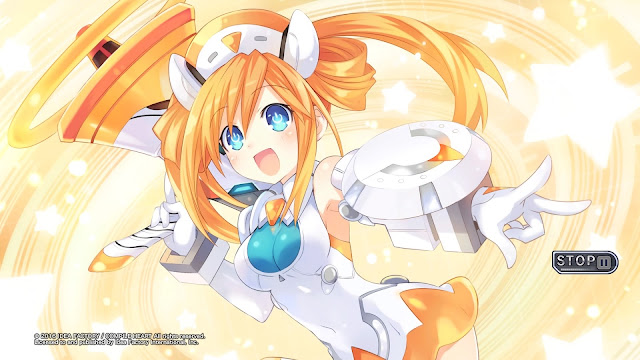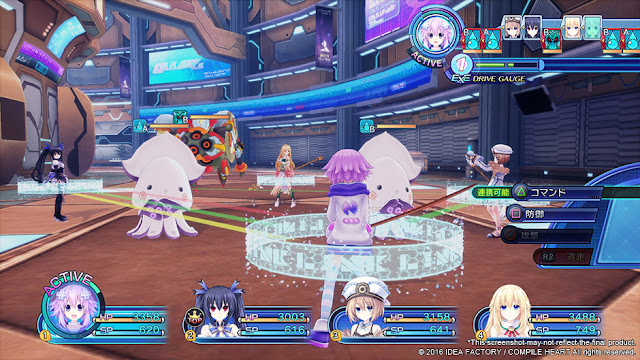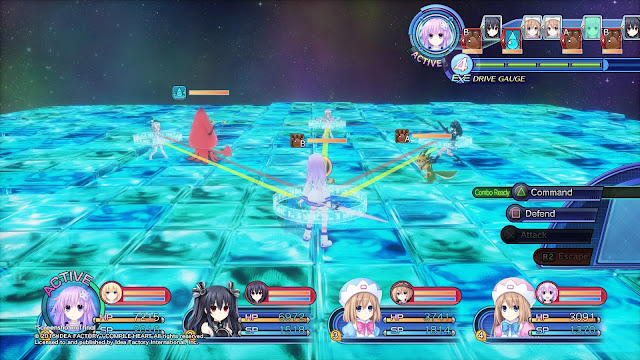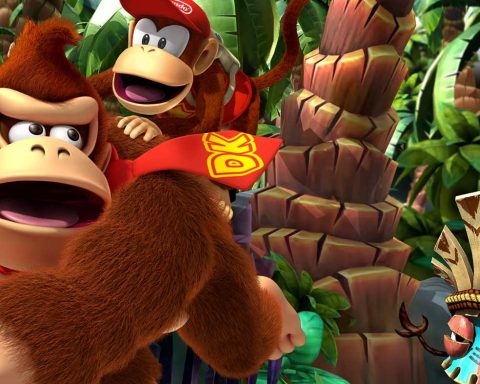Gametrailers recently included the Hyperdimension Neptunia series in a “top 10 game franchises that need to die” clickbait feature. What utter nonsense; as we can see with Megadimension Neptunia VII, the series continues to go from strength to strength, and you don’t let a series “die” when it’s doing that.
Related reading: Looking to play the series through from the start? Hyperdimension Neptunia Re;Birth 1 is the place you want to start. Matt’s full review.
Most people are familiar with the basic premise of Hyperdimension Neptunia by now, but to refresh it in a couple of lines: the series is a running satire on the politics of the video game industry, and it achieves that satire by taking the game consoles and companies within the industry, and then personifying them in the form of cute anime characters. It’s silly – deliberately so – but people who go into these games with an open mind generally find themselves quickly enamoured with the energy and bright, airy sense of humour.
In Megadimension Neptunia VII, the first outing of the series on the PlayStation 4, and the first new canonical game in the franchise since Hyperdimension Neptunia Victory was released on the PlayStation 3 in 2012, we kick things off as Neptune and Nepgear, the two main leading ladies of the series, find an old, forgotten game console that is-totally-but-not-really a Dreamcast. On firing it up some magic happens and they are whisked into an apocalyptic world where all people are gone, giant robots and monsters continue on a murderous rampage despite the fact they don’t actually have much to kill, and of what’s left it all looks vaguely and eerily like the Nep girls’ “real” home.
Without giving too much of the plot away (though it is thoroughly predictable from the outset anyway), this “new” setting has allowed for the development team to get creative and come up with new characters to join the existing cast. Neptune and Nepgear are “CPUs” – or Godlike beings – and in the existing Neptunia universe they, as well a couple of others (Blanc, Noire, Vert, etc), were really all the fiction could handle, so there wasn’t really room to introduce any more while staying true to the original Hyperdimension setting. Compile Heart has already used inter-dimension travel as a narrative gimmick to introduce a new character in Hyperdimension Victory, and this time around the plot goes to even greater contrivances to give us all-new characters. Key among those is the wonderful Uzume – who has instantly shot up the rankings to be one of my favourites.
And that’s just the first chapter. Megadimension is broken up into three very different chapters, that are paced out a little like a three-act play, with each chapter veering off in a significantly different direction to both support a fairly thin overarching narrative with a series of more concentrated mini-stories. Chapters jump across regions and have entirely different casts, for example, one chapter features a crew of four based on the four largest Japanese publishers – Square Enix, Bandai Namco, Capcom and Konami – and a special mention there needs to go to the Square Enix girl, who does a brilliant job of being both homage and complete send up of everything we love (and hate) about Square.
It all works, in the sense that Megadimension Neptunia feels like it’s the product of someone writing while lucid dreaming; it makes sense right up to the point where you start applying logic to it. Then the narrative breaks down quite quickly. Series veterans won’t care, as they come to the series for the oddball cast, fan service and sense of humour. More serious souls might find it difficult to resolve themselves to primary narrative at first, because the way it tells its stories is in a very Japanese fashion, and that doesn’t necessarily resonate with those of us in the west. But, again, if they go into it with an open mind they should also find themselves happy to be taken along for a ride. There’s a reason that Japanese theatre, such as kabuki and noh, don’t tend to go over so well in the west. Megadimension Neptunia’s pacing puts it in a very similar tradition. That’s not to say it’s bad, by any means. It just requires a certain degree of cultural sensitivity towards Japan to really appreciate.
Anyhow, I digress. Back on the game, and something worth noting is how completely unfriendly the narrative is to newcomers. There’s no explicit need to have played previous games to follow along with what Megadimension Neptunia is offering, but if you’ve skipped the three previous “canon” Hyperdimension Neptunias, then you are going to feel like you were dropped in the middle of a pretty intense conversation, with no way of catching up before the other people in the conversation start expecting you to join in. The characters returning from previous Hyperdimension titles rely as much on what we already knew about them going in as what we see in the game itself. Given that this is the first entry for the series on the PlayStation 4, I find this an odd decision, and it almost feels like Compile Heart has thrown in the towel and has now lost interest in finding new fans for the Nep crew.
Related reading: Hyperdimension Neptunia is also in anime form! Matt’s review of that here.
Then again, with Hyperdimension Neptunia titles readily available on PS3, Vita and PC, it’s probably a safe assumption to make that most people that might have been interested in playing this series already have.
Once you’re comfortable with the characters, Megadimension Neptunia is all about the humour, and it is indeed a very funny game. That it is so funny is odd on one level, as it is a very dark apocalypse the characters are facing, including the very real potential for the entire world to be simply snuffed out of existence. It’s not the first time Compile Heart has attacked an apocalypse with moe – Omega Quintet similarly drowns the misery and doom hanging in the air with cute, tiny miniskirts and pretty hairdos, but I find it consistently curious how the writers go about mixing the rawest horror that we can imagine as humans – a manifestation of annihilation – with raw comedy… and I’m not sure many other developers would even have the proverbial gonads to try. Equally fascinating is that for all the accusations of idiocy that is levelled at the series, these games are comedy with meaning; as a series that takes a self-reflective dissections of the games industry and the various political and social debates that we have within it, there’s actually some ripping sharp commentary in there.
It’s also a series that’s more than happy to break down the fourth wall, too, is self-deprecating, and throws in some pop culture humour for good measure. The pop culture humour does tend to give the game a countdown to irrelevance and there are jokes in here that simply won’t resonate with audiences ten years down the track, as there are jokes in the original Hyperdimension Neptunia that, six years since it was originally released, will either fly over the head of players or illicit a groan from them. For now, however, Megadimension Neptunia is quite on point, and while some of the jokes cannot be said to be in good taste, there’s some solid insights that we can pull from them.
Next is the fan service, which is itself played to the furthest extremities possible in a bid to build additional humour. With characters designed by Tsunako, the absolute master of otaku art design, every one of the Hyperdimension Neptunia characters is visually striking, and the game takes great pleasure in sticking the all-girl cast in costumes that are designed more around showing their underwear and/or chest than concealing either. Though Megadimension Neptunia continues the series trend of presenting cut scenes as largely static screens of characters talking to one another in dialogue boxes, the in-game engine is far superior on the PlayStation 4, and the character models are detailed and animate well. It’s a budget game, but as we saw with Omega Quintet previously, Compile Heart really knows how to work within the budgetary limitations they have to still craft a game with which the characters, if not necessarily the backgrounds, are a distinct step up from what was possible on previous consoles.
That being said, where the fan service really picks up is in the occasional static art screen, which is used to highlight “key” moments in the narrative. And by “key” I do actually mean any scene in which one or multiple girls have a reason to be undressed as far as age classification boards would allow before rating them as pornography. Each Hyperdimension Neptunia game has been steadily ramping up the explicitness of these art pieces, and there is literally nowhere else the series can go from here. Within the first hour of Megadimension Neptunia, for example, you’re gifted with a shower scene where Neptune’s nipples (and quite literally only her nipples) are covered only by the thinnest drops of water, and the only thing concealing her naked crotch is a strategically placed tie from another character, who is also in the process of undressing (bared backside facing the world, no less). I can’t actually put a screenshot of it on this review because it would violate various rules around nudity, or I would, just to show how far Compile Heart was willing to go to push the boundaries with this one.
But I’m not complaining about these scenes on any level, as they both suit and reinforce the self-referential nature of the game, and, it’s important to note, that they never disempower the girls in any way. This is key. There is a sense of empowerment that runs through the Hyperdimension Neptunia games; a respect for the agency of the God-like characters that cuts through the humour and, in those moments where it is time to get serious, these girls always prove to be paragons of integrity and justice. Yes, there’s a sense of voyeurism that runs through the whole thing, but it’s keenly self-aware, and in those moments where it breaks down the fourth wall, Megadimension Neptunia is more comfortable making jokes at the expense of its own audience for indulging in that voyeurism than any other game series out there.
In terms of gameplay, Compile Heart have taken the opportunity to subtly enhance the core mechanics that have driven previous Hyperdimension games without overthrowing a system that has come to really work for the series. As with the previous games, battles take place inside a small area, with player characters and enemies taking turns to have at one another. It’s a fairly standard turn-based system, with each character having a distinct set of special abilities, but one extra that has been thrown in is the ability to have characters “transform” into a God-like form that enhances their power, while steadily draining their energy resources. It’s a simple system but it does force players to have a good sense of strategic timing when it comes to the boss battles in order to maximise the critical extra power at the right time.
However, for Megadimension Neptunia there are a couple of additional features that have been added in that enhance the strategy a little further over its predecessors. You’re encouraged to make good use of space, for example, with characters able to launch a really powerful team-based attack if they’ve circled around an enemy. It’s also possible to do damage to specific areas of the enemy anatomy to slowly break them down. These features aren’t massive inclusions, but they do help to up the long-term engagement value of the combat system.
Also helping that are the enemies, which remain a fun bunch. A great many of them are parodies of game characters/ features of Japanese popular culture. For example you’ll be fighting space invaders, pipes from the Mario Bros. series, and, literally, game screenshots. It’s not the most difficult combat system out there, especially once you’ve come to grips with some of the behind-the-scenes stuff, like partnering characters with one another and setting up their skills. In fact, about halfway through the game Compile Heart’s ability to scale difficulty fairly loses the race in your ability to break it, making for a really quite easy combat system for the experienced.
But it’ll remain challenging enough for the less experienced, and to be perfectly honest it’s not the kind of game I’m looking to get challenge out of anyway. And, if you do want to, there’s plenty of optional stuff outside of the main narrative that you can get stuck into for a higher degree of difficulty.
One final note worth mentioning is that Megadimension Neptunia VII follows Compile Heart’s usual struggles to actually explain what’s going on. The tutorials are static blocks of text to read, but they don’t do a great job in explaining to players how to properly set up the kinds of attack combinations and special abilities that they’ll need through the game. Some trial and error will get you there, but it’s another point of contention that will make it more difficult for newcomers to get into the game than was strictly necessary. Compile Heart might want to concentrate on that more with the inevitable next Megadimension Neptunia title, because this series has got to the point where the gameplay foundations are strong enough that it deserves an expanded audience (well, to an extent. Thanks to that fan service it’s never going to be mainstream, despite its quality).
Far bigger in scope than any of its predecessors, Megadimension Neptunia VII has nevertheless managed to retain its focus over what fans enjoy about the series most; its humour and its fan service. This game should be enough to get people who have waned on the series back into the fold, thanks to the additional characters, vastly improved graphics engine, and expanded plot and combat system. It won’t be enough to get the series removed from Gametrailers’ list of franchises that need to die, but to be honest I don’t think Neptune gives a toss.
– Matt S.
Editor-in-Chief
Find me on Twitter: @digitallydownld


